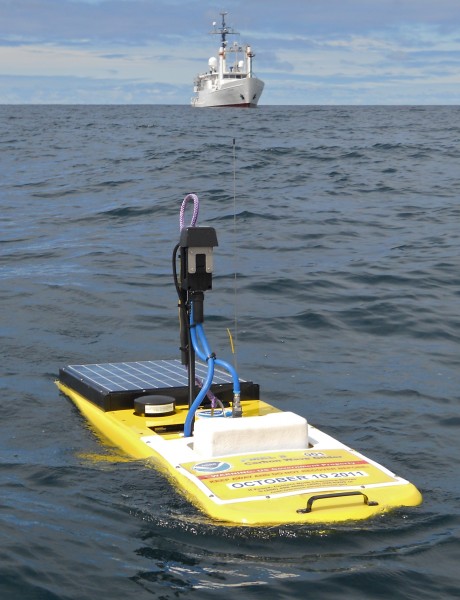New ocean acidification study launched in Prince William Sound
April 29, 2014

907-474-7208
4/29/14
Beginning this week, two surface wave gliders resembling yellow surfboards will cruise around Prince William Sound as part of a five-month monitoring program to measure ocean acidification. Simultaneously, state-of-the-art instrumentation installed on a glacier tour boat will monitor glacial runoff, while an underwater autonomous glider patrols beneath the surface looking for plumes of water that could be harmful to some species.
The project, funded mostly by the National Oceanic and Atmospheric Administration’s Ocean Acidification Program, is led by Jeremy Mathis, director of the University of Alaska Fairbanks Ocean Acidification Research Center and supervisory oceanographer of the NOAA Pacific Marine Environmental Laboratory in Seattle, and Wiley Evans, a research associate with the ĐÔÓűÉç acidification center, in partnership with the Alaska Ocean Observing System.
Scientists estimate that the ocean is 25 percent more acidic today than it was 300 years ago, largely due to increasing levels of atmospheric carbon dioxide from burning fossil fuels and changes in land use. Almost half of the CO2 emitted remains in the atmosphere, with the land and ocean absorbing the rest. When the ocean absorbs CO2, its pH balance changes through a process called ocean acidification. Because cold water can absorb more CO2 than warm water, acidification can disproportionately impact coastal regions around Alaska.
Recent publications by Mathis and Evans have shown that the process of ocean acidification may be worsened around tidewater glaciers due to the freshwater melt plumes that occur is summer and fall.
“The glacier melt plumes have some really unique chemistry that can exacerbate ocean acidification and impact the environment in Prince William Sound and out into the Gulf of Alaska,” Mathis said. “Our goal is to use the latest technology to find out what’s happening so we can communicate that to Alaska residents and stakeholders."
According to AOOS executive director Molly McCammon, the research effort builds upon the partnership developed with the Ocean Acidification Research Center, housed within the ĐÔÓűÉç School of Fisheries and Ocean Sciences, to support statewide ocean acidification monitoring. The consortium supports five buoys around the state, as well as twice-per-year sampling in the Gulf of Alaska, and development of a Gulf of Alaska acidification forecast model. Data from the monitoring efforts will be available on both the ĐÔÓűÉç Ocean Acidification Research Center website () and the AOOS website ().
“With this new effort, we’re increasing our ability to view and understand Alaska’s oceans in four dimensions — two dimension space, depth and time,” said McCammon.
When completed in early September, this summer’s study will have provided the longest continuous observations of ocean acidification in Alaska to date.
“We are very proud to have the opportunity to partner with AOOS and be the leaders in glider technology in Alaska,” said Mathis. “This work could be a game-changer in our understanding of how ocean acidification will impact our state.”
ADDITIONAL CONTACTS: Jeremy Mathis, 305-338-5070, jeremy.mathis@noaa.gov. Wiley Evans, 541-207-5943, wiley.evans@alaska.edu
ON THE WEB: www.sfos.uaf.edu/oarc/
NOTE TO EDITORS: Photos are available for download at .
MG/4-29-14/301-14


